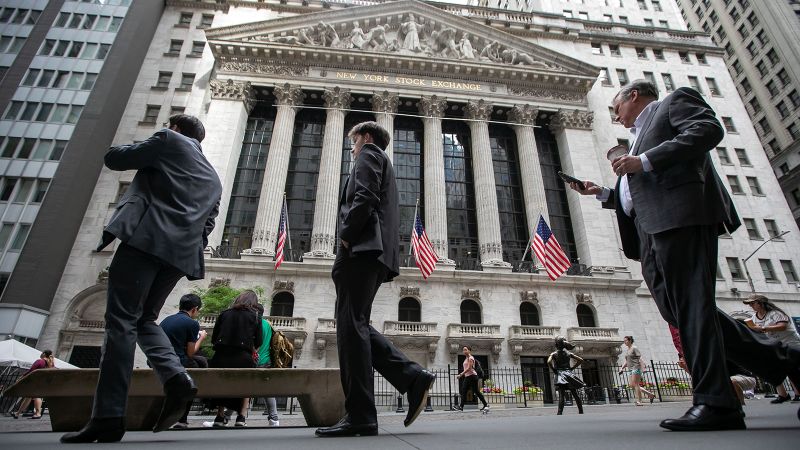A version of this story first appeared in CNN Business’ Before the Bell newsletter. Not a subscriber? You can sign up right here. You can listen to an audio version of the newsletter by clicking the same link.
Wall Street is being dealt a rare double feature of economic news on Wednesday, when an inflation report is due in the morning and the Federal Reserve is expected to announce what it will do with its key interest rate in the afternoon.
What to expect: Investors will parse the May Consumer Price Index report on Wednesday morning, just hours before the Fed is slated to announce its monetary policy update. The CPI report and Fed’s policy meeting have fallen on the same day just seven times since 2014, according to Bank of America. Despite the rare event, it’s unlikely the stock market will swing widely because of the economic two-fer, some investors say.
“The things that could drive volatility higher would be if Chair Powell was to say something unexpected; I think that is of a very low probability,” wrote Dave Sekera, chief US market strategist at Morningstar, in a Monday note. But if “inflation metrics come out much higher than expected, that could lead to a small sell-off. How much the market sells off would depend on how much above consensus inflation is running.”
The central bank is widely expected to keep rates on hold this month. Some analysts say upcoming CPI data won’t alter the Fed’s June decision, unless it shows a huge deceleration or acceleration in inflation. But the metric will still help guide the Fed’s decisions during the second half of the year.
“The number of rate cuts the Fed will actually be able to deliver this year will depend heavily on the outlook for inflation; if it remains stickier, investors may want to temper their expectations for easing for 2024,” wrote Glenmede’s investment strategy team in a Monday note.
Inflation is coming down, but the path could be bumpy. Inflation showed signs of cooling in April after staying worryingly warm during the first quarter of this year. There are also signs that Americans are spending less: A second estimate of gross domestic product, released in May, showed that consumer spending was weaker in the first three months of the year than initially reported. Big-box retailers are cutting prices to entice price-conscious consumers.
Investors are looking to the May CPI for clues about whether that cooldown in April’s CPI report was a blip. Already, other metrics have suggested that inflation is still taking its time to come down. The April Personal Consumption Expenditures index, the central bank’s preferred inflation gauge, showed the US economy made little progress keeping costs in check. US home prices are at record highs. Prices for used and new cars are still running hot, as are costs for insuring, repairing and maintaining them.
The latest jobs report released Friday revealed that the US economy added an eye-popping 272,000 jobs in May. The combination of persistent inflation and strong job growth has led Wall Street to pare its expectations for rate cuts this year. Traders are expecting just one to two cuts in 2024, according to the CME FedWatch Tool.
The Fed on Wednesday will release its latest projections for where it expects rates to head in the future, and, importantly, how many times it expects to ease rates in 2024. Although the central bank has stuck to its forecast for three rate cuts so far this year, that could change — and potentially become the final set of 2024 projections.
“If most of the [Federal Open Market Committee] participants assume only one 25 [basis point] rate cut this year is appropriate, there would appear to be little chance of sufficient data in time to pull them back into a July or September rate cut,” wrote UBS economists in a Friday note.
Americans are feeling rosier about their finances, the stock market and inflation’s decline
Presidential election polls may be showing that some Americans have mixed, if not outright sour, views on the overall economy — but when it comes to how they view their own finances, things are looking pretty good, reports my colleague Alicia Wallace.
US consumers are more optimistic about their current and future financial situation, the stock market and slowing inflation, according to survey data released Monday by the Federal Reserve Bank of New York.
The New York Fed’s May Survey of Consumer Expectations showed improvement of people’s perceptions of their current financial situation as well as their outlook for a year from now. The share of respondents who said their financial situation was better than in May 2023 was at its second-highest level in more than two years, while the year-ahead positive share landed at its highest level in nearly three years.
Monday’s survey also showed improved optimism beyond the homefront: Notably, consumers believe the markets’ good times could keep rolling. Households’ expectations for highest US stock prices improved to a three-year high.
In terms of the labor market, the latest survey was a little mixed.
Read more here.
America’s rural hospitals keep getting attacked by cybercriminals. Microsoft and Google are working to fix that
Microsoft and Google will offer free or discounted cybersecurity services to rural hospitals across the United States to make them less vulnerable to cyberattacks that have disrupted patient care and threatened lives, the White House and those tech firms said Monday.
Microsoft said in a statement to CNN that it would provide free security updates for eligible rural hospitals, as well as security assessments and training for hospital staff. Google will provide free cybersecurity advice to rural hospitals and start a pilot program to match the firm’s cybersecurity services with the needs of rural hospitals.
The nation’s roughly 1,800 rural community hospitals are among the most vulnerable to dangerous ransomware attacks because they often lack IT security resources and cybersecurity-trained staff, report my colleagues Sean Lyngaas and Michelle Watson. And they may be the only hospitals within dozens of miles, meaning a ransomware attack that prevents a hospital from accepting ambulances can put patients’ lives at risk.
The new announcement is the result of private discussions between the tech firms and officials at the White House National Security Council which has grown increasingly concerned about cyber threats to hospitals. It’s an effort to use the broad reach of Microsoft and Google’s software, which is used in hospitals across the United States, to help plug a gap in the defense of the health care sector.
Read more here.
Read the full article here




